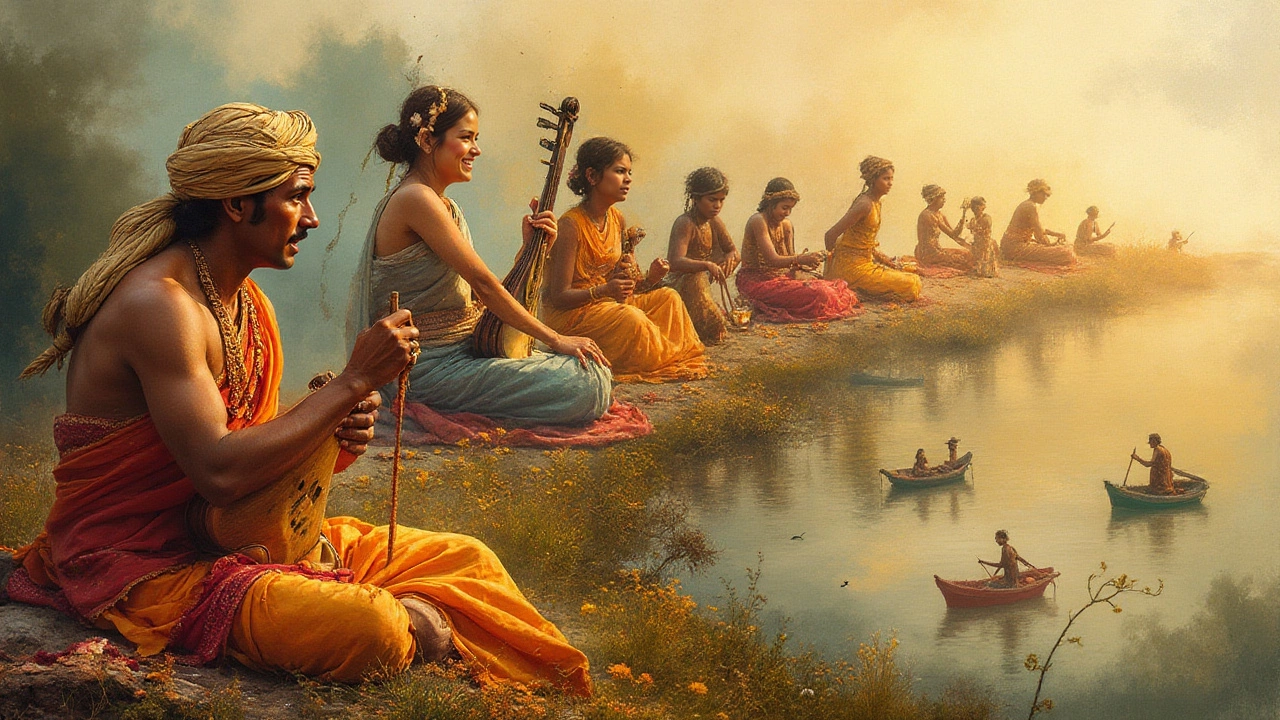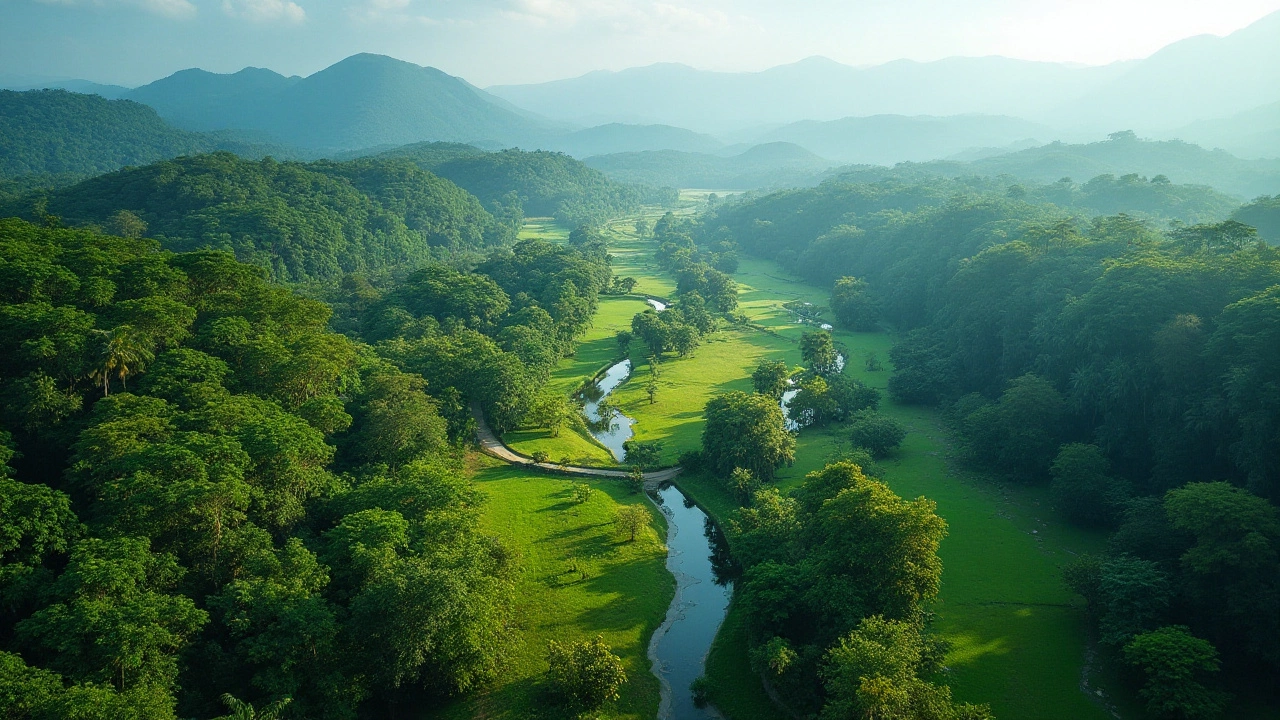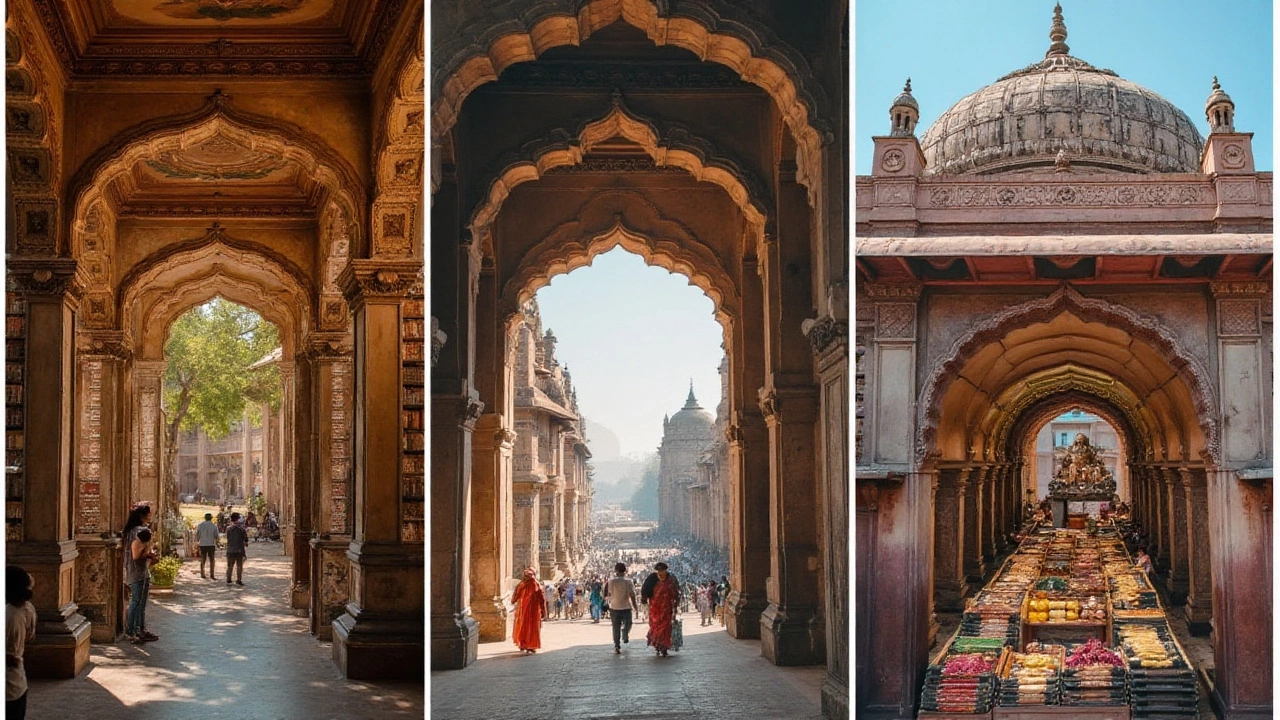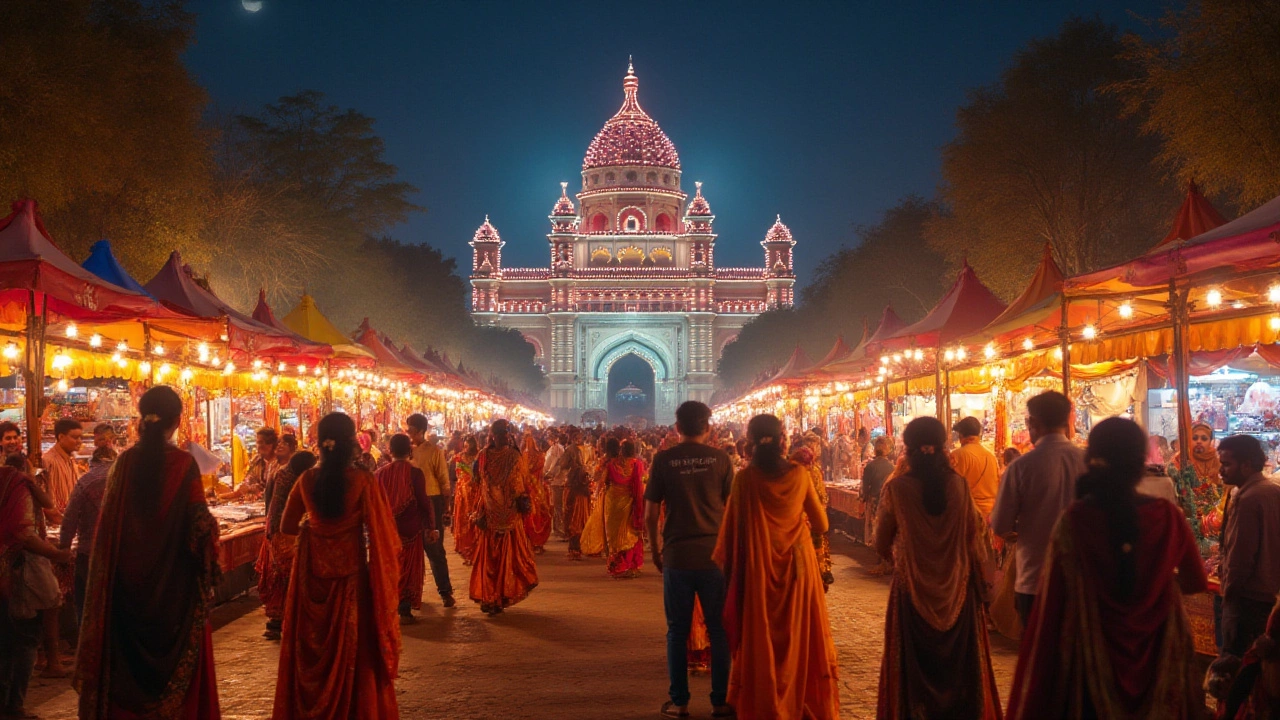India, a nation known for its vibrant culture and ancient history, boasts a wealth of cultural heritage that captivates millions around the globe. Each region of this diverse country offers a unique lens into its past, revealing stories woven into the fabric of everyday life.
Understanding India's heritage is like opening a treasure trove of experiences, each with its own tale to tell. Whether it’s the mesmerizing architecture, the melodious tunes of a classical raga, or the breathtaking landscapes, India's cultural patrimony is both profound and varied. Let's dive into the five distinct types of heritage that form the bedrock of this incredible country's identity.
Tangible Heritage
India's Tangible Heritage is renowned for its architectural marvels and ancient artifacts that tell stories of bygone eras. This physical form of cultural heritage includes monuments, buildings, and archaeological sites that carry the imprints of history and the evolution of several civilizations. These structural wonders are not merely remnants of stone and mortar but are silent witnesses to India's fascinating past, embodying a medley of emotions, beliefs, and traditions that have shaped the nation. Let's embark on a journey to uncover what makes India's tangible heritage such an intriguing tapestry woven with historical richness.
One cannot discuss tangible heritage without mentioning the iconic Taj Mahal, set majestically on the banks of the Yamuna River in Agra. Built by the Mughal emperor Shah Jahan in memory of his beloved wife Mumtaz Mahal, this white marble mausoleum is a tribute not just to love but also to the extraordinary craftsmanship of that era. Housing intricate carvings and precious stone inlays, the Taj Mahal stands as a crown jewel of Mughal architecture, attracting millions of visitors who come to witness its magnificence. Importantly, it serves as a prime example of the harmonious blend of Persian, Islamic, and Indian architectural styles, which is emblematic of the Indian cultural mosaic.
Another exemplary piece of tangible heritage is the ancient city of Hampi. Recognized as a UNESCO World Heritage site, Hampi was once a thriving capital of the Vijayanagara Empire during the 14th century. Amongst its numerous ruins, one can find the Virupaksha Temple, adorned with ornate carvings and grandiose structures, showcasing the height of Dravidian architecture. A visitor to Hampi can almost hear the echoes of bustling marketplaces and the grandeur of the royal courts. Few places encapsulate history as beautifully as Hampi, where the stones themselves seem to narrate tales of triumph and turmoil.
The Ajanta and Ellora Caves further highlight India's rich tapestry of tangible heritage. Carved out of solid rock in Maharashtra, these caves date back to between the 2nd century BCE and the 6th century CE. Ajanta is famed for its exquisite frescoes and sculptures, depicting scenes from the life of Buddha and ancient Jataka tales, all carved meticulously into rock. Ellora, on the other hand, is an amalgamation of Buddhist, Hindu and Jain influences; the Kailasa Temple, dedicated to Lord Shiva, is particularly astounding, carved entirely from a single rock. Art historians often refer to these caves as milestones in the history of Indian art and religious culture, noting the diversity and complexity in their themes.
"The whole of life seems to be expressed in these enormous temples; laughter and tears, monsters and gods, are present in multitudes, and the rock is worn away into forms of strange subtlety and grace." — William Archer, renowned British writer.
Preserving these magnificent contributions to Indian heritage is crucial not only for those within the nation but also for the global community, offering insights into humanity's shared history and accomplishments. These sites of tangible heritage provide a gateway to understanding the incredible diversity and cultural richness that India presents to the world.
Through ongoing preservation efforts and responsible tourism, we can ensure that India's tangible heritage continues to inspire and educate future generations, fostering a deeper appreciation for the cultural legacies that have been passed down through centuries.
| Heritage Site | Location | Year Recognized |
|---|---|---|
| Taj Mahal | Agra, Uttar Pradesh | 1983 |
| Hampi | Karnataka | 1986 |
| Ajanta Caves | Maharashtra | 1983 |
| Ellora Caves | Maharashtra | 1983 |

Intangible Heritage
The essence of India's cultural identity often resonates in its intangible heritage, which transcends physical boundaries to capture traditions passed down through generations. Unlike tangible heritage, which includes physical manifestations, intangible heritage includes practices, expressions, knowledge, and skills that are deeply embedded in social practices. It is a living expression, embodying the spirit of communities over the ages, and playing a crucial role in sustaining vibrant culture. Festivals like Diwali and Holi mark the blending of culture, faith, and joy, each with its roots deeply entrenched in age-old teachings and customs. These festivals are celebrated with grandeur, stories, and rituals that convey the collective memory and wisdom of past generations. Functions, whether they be weddings or harvest festivals, often demonstrate a way of living harmoniously within society.
Take, for example, the classical dance forms of Bharatnatyam, Kathak, and Odissi. They aren't just dance styles; they're art forms that tell stories of gods, goddesses, and significant events from Indian mythology. The intricate footwork and expressions in these dances are preserved as a symbol of India's age-old traditions. Over time, these art forms have evolved while maintaining their core essence, reflecting the region's unique mythology and philosophy. Interestingly, India's cultural heritage is reflected in its music as well, with different territories housing unique styles and instruments, each adding to the country's musical mosaic.
"When you listen to Indian classical music, it is not just rhythm and melody. It fills you with happiness as it connects with the traditional forms that existed since time immemorial," says Pandit Ravi Shankar, a renowned sitar virtuoso.
Language, yet another pillar of intangible heritage, tells stories of cultural interactions that have occurred throughout the ages. India is home to 22 officially recognized languages, and each language has its literature, folklore, and oral traditions. These languages and dialects illustrate the tapestry of local history and culture. A storytelling tradition such as 'Katha', which is prevalent in Western India, embodies the art of oral storytelling that blends history, myth, and religion. It serves as a vehicle for passing crucial life lessons from one generation to the next. Moreover, with globalization, the need to preserve these traditions has increased manifold, encouraging initiatives to educate the youth about their wealthy heritage. Lastly, it's important to note that intangible heritage is ever-evolving. It adapts and transforms while maintaining its core facets, which makes preserving it challenging but essential. This dynamic nature ensures its relevance to people's lives and helps communities connect with their ancestry, giving them a sense of belonging in a rapidly changing world.

Natural Heritage
India’s natural heritage is as spectacular as its cultural history, offering everything from snow-capped mountains to lush green forests, desert landscapes, and an extensive coastline. The country's geographical diversity provides a habitat for a staggering variety of fauna and flora, some found nowhere else on earth. India's commitment to conservation is evident through its numerous national parks, wildlife sanctuaries, and biosphere reserves, which strive to protect its natural treasures.
The majestic Himalayas serve as the northern boundary, home to a rich tapestry of ecosystems and some of the country's most iconic wildlife species. Among the protected areas, the Great Himalayan National Park stands out, recognized as a UNESCO World Heritage Site for its biodiversity. Here, you can find snow leopards, Himalayan brown bears, and over 375 recorded species of fauna. It’s a testament to India’s dedication to preserving its natural biosphere. The Western Ghats, another biodiversity hotspot, is also a crucial site, hosting unique biodiversity that supports over 7,402 species of flowering plants.
India’s rivers, such as the Ganges and Brahmaputra, are not only vital lifelines for millions of people but also crucial ecological zones. The Sundarbans, with their famous mangrove forests, house the Royal Bengal Tiger along with a variety of reptiles and aquatic life, making it another gem in India's natural legacy. A recent study revealed that India's forests serve as carbon sinks that absorb up to 300 million tons of carbon dioxide each year, which is critical in managing climate change.
Preservation Efforts
The conservation efforts extend beyond flora and fauna. Policies aimed at promoting eco-tourism have seen states actively engaging tourists in conservation activities. Educational programs run by various NGOs focus on raising awareness about the importance of preserving these natural landscapes. Community-led projects often bring together traditional knowledge and modern science, ensuring India's natural treasures are protected for future generations. In the words of renowned wildlife photographer and conservationist Valmik Thapar, "India is like a living museum, where every corner speaks of the planet’s ecological history..."
Indian citizens are increasingly playing a role in these preservation efforts, with mobile apps and platforms encouraging public participation in wildlife tracking and reporting. This dynamic approach not only aids in conservation but also bridges the gap between people and nature. Celebrating World Environment Day by planting trees or keeping water bodies clean has become commonplace in many Indian cities and towns. This collective effort ensures that India’s natural heritage remains an integral part of its story.

Movable Heritage
When we think of movable heritage, we touch on an exciting dimension of India's cultural legacy. It encompasses artifacts that can be physically transported, taking rich stories across borders, preserving history in tangible forms. These treasures include elusive pieces like ancient manuscripts, vibrant paintings, and exquisite sculptures, each transporting a piece of the past into our modern world. The role of museums, galleries, and private collectors is pivotal in the safeguarding of these artifacts, ensuring that generations can admire and learn from these remnants of history.
The diversity of India's movable heritage is vast and profound, with each artifact echoing the craftsmanship of its time and place. Take, for instance, the mesmerizing Chola bronzes, celebrated worldwide for their grace and poise, encapsulating the pinnacle of South Indian bronze artistry. On another hand, there are intricately detailed Mughal miniatures that depict royal life with color and precision. They're not just artistic masterpieces but windows into the epochs that shaped the Indian subcontinent.
As the renowned Indian historian Romila Thapar once said, "Artifacts are the whispers of history, reminding us where we came from and the journey ahead."
Preserving these delicate pieces poses challenges. Environmental factors, handling, and even political conflicts can threaten their integrity. This is where technology plays a crucial role, with advances like digital archiving and 3D scanning helping protect our fragile movable heritage without compromising accessibility. Institutions worldwide are making efforts to digitize their collections, offering virtual glimpses into artifacts that might otherwise be unreachable.
The roles of craftsmen cannot be understated as they often serve as protectors of knowledge systems, ensuring the survival of traditional techniques. Families might pass down the secrets of weaving a sari or sculpting a stone, making the art itself part of our movable heritage. India's rich tradition of craftsmanship continues to evolve, merging traditional skills with contemporary designs. While adaptation is essential, it's crucial to uphold the core essence of these crafts, as losing them would mean fading away important cultural chapters.
For enthusiasts and learners alike, understanding India's movable heritage offers a compelling journey through time. It reminds us to cherish the stories these objects tell, to value the expertise they embody, and to feel inspired by the beauty they present. It's not merely about preserving items in glass cases but fostering an appreciation and connection that bridges the past to the dynamic future of Indian culture.
